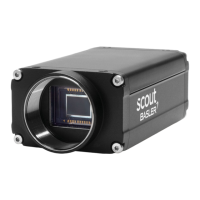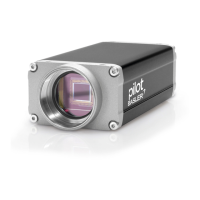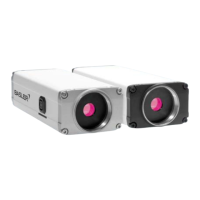AW00089317000 Image Acquisition Control
Basler ace GigE 151
You may have to add additional delays to the exposure start delay:
If you use a hardware signal to trigger image acquisition, you must add a delay due to the input
line response time. Note that such delays are associated with the acquisition start trigger
signal and the frame start trigger signal.
For more information about the input line response time, see Section 5.7.3 on page 65.
If you use the debouncer feature, you must add the delay due to the debouncer setting.
For more information about the debouncer feature, see Section 6.1.2 on page 72.
If you have set a frame start trigger delay, you must add the delay due to the frame start trigger
delay setting.
For more information about the frame start trigger delay, see Section 7.4.3.3 on page 106.
For example, assume that you are using an acA640-120 camera and that you have set the camera
for hardware triggering. Also assume that you have selected input line 1 to accept the hardware
trigger signal, that the input line response time is 1.5 µs, that the delay due to the debouncer setting
for input line 1 is 5 µs, and that you set the frame start trigger delay to 200 µs.
In this case:
Total Start Delay =
Exposure Start Delay (Table 20) + Input Line Response time + Debouncer Setting + Frame Start
Trigger Delay
Total Start Delay = 17.62 µs + 1.5 µs + 5 µs + 200 µs = 224.12 µs
You can determine the readout time by reading the value of the Readout Time Abs parameter. The
parameter indicates what the readout time will be in microseconds given the camera’s current
settings. You can read the Readout Time Abs parameter value from within your application software
by using the Basler pylon API. The following code snippet illustrates using the API to get the
parameter value:
double ReadoutTime = Camera.ReadoutTimeAbs.GetValue( );
You can also use the Basler pylon Viewer application to easily get the parameter value.
For more information about the pylon API and the pylon Viewer, see Section 3 on page 45.
You can calculate an approximate frame transmission time by using this formula:
Note that this is an approximate frame transmission time. Due to the nature of the Ethernet network,
the transmission time could vary. Also note that the frame transmission cannot be less than the
frame readout time. So if the frame transmission time formula returns a value that is less than the
readout time, the approximate frame transmission time will be equal to the readout time.
Due to the nature of the Ethernet network, the transmission start delay can vary from frame to
frame. The transmission start delay, however, is of very low significance when compared to the
transmission time.
For more information about the Payload Size and Device Current Throughput parameters, see
Section Appendix B on page 343.
~ Frame Transmission Time
Payload Size Parameter Value
Device Current Throughput Parameter Value
-----------------------------------------------------------------------------------------------------------------------=

